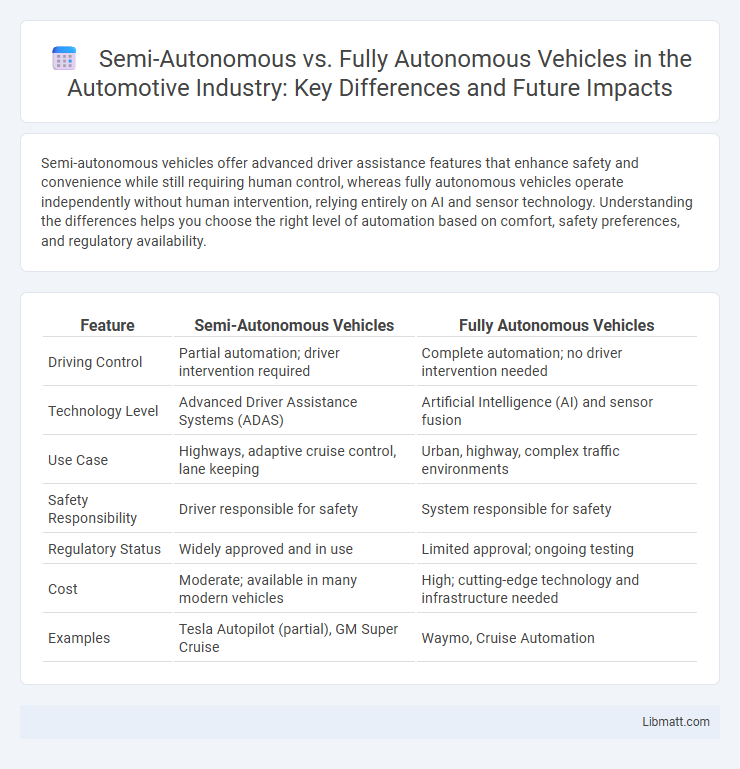Semi-autonomous vehicles offer advanced driver assistance features that enhance safety and convenience while still requiring human control, whereas fully autonomous vehicles operate independently without human intervention, relying entirely on AI and sensor technology. Understanding the differences helps you choose the right level of automation based on comfort, safety preferences, and regulatory availability.
Table of Comparison
| Feature | Semi-Autonomous Vehicles | Fully Autonomous Vehicles |
|---|---|---|
| Driving Control | Partial automation; driver intervention required | Complete automation; no driver intervention needed |
| Technology Level | Advanced Driver Assistance Systems (ADAS) | Artificial Intelligence (AI) and sensor fusion |
| Use Case | Highways, adaptive cruise control, lane keeping | Urban, highway, complex traffic environments |
| Safety Responsibility | Driver responsible for safety | System responsible for safety |
| Regulatory Status | Widely approved and in use | Limited approval; ongoing testing |
| Cost | Moderate; available in many modern vehicles | High; cutting-edge technology and infrastructure needed |
| Examples | Tesla Autopilot (partial), GM Super Cruise | Waymo, Cruise Automation |
Introduction to Vehicle Autonomy
Vehicle autonomy ranges from semi-autonomous systems that assist drivers with specific tasks like lane-keeping and adaptive cruise control to fully autonomous vehicles capable of navigating complex environments without human intervention. Semi-autonomous vehicles require continuous driver supervision, whereas fully autonomous vehicles leverage advanced sensors, machine learning, and AI algorithms to make real-time decisions independently. Your safety and convenience depend on understanding these distinctions as the technology evolves towards widespread adoption.
Defining Semi-Autonomous Vehicles
Semi-autonomous vehicles feature advanced driver-assistance systems (ADAS) that enable partial control, such as lane-keeping, adaptive cruise control, and automated braking, but still require human intervention for complex decisions and full navigation. These vehicles rely on sensors, cameras, and radar to monitor surroundings, providing assistance without completely replacing the driver's role. Unlike fully autonomous vehicles classified as Level 5 automation by SAE International, semi-autonomous models operate within lower levels (Levels 2-3), combining human judgment with automated functions.
What Are Fully Autonomous Vehicles?
Fully autonomous vehicles are equipped with advanced sensors, machine learning algorithms, and integrated navigation systems that enable them to operate without human intervention. These vehicles utilize technologies such as LiDAR, radar, and computer vision to perceive their environment and make real-time driving decisions. Fully autonomous vehicles are designed to handle complex traffic scenarios, adapt to changing road conditions, and ensure passenger safety through continuous self-monitoring and communication with surrounding infrastructure.
Key Differences Between Semi and Fully Autonomous Cars
Semi-autonomous vehicles require human intervention for certain driving tasks, such as steering or braking, while fully autonomous cars operate independently without any human input. Key differences include the level of automation, sensor integration, and decision-making capabilities, with fully autonomous vehicles relying on advanced AI algorithms and comprehensive sensor arrays to navigate complex environments. Your safety and driving experience depend on the vehicle's ability to handle real-time data and execute precise maneuvers without relying on human oversight.
Technology Behind Autonomous Vehicles
Semi-autonomous vehicles utilize advanced driver-assistance systems (ADAS) such as adaptive cruise control, lane-keeping assist, and automated braking, relying on a combination of cameras, radar, and ultrasonic sensors to enhance driver control. Fully autonomous vehicles integrate more sophisticated technologies including LiDAR, high-definition mapping, artificial intelligence, and machine learning algorithms to enable complete self-driving capabilities without human intervention. The transition from semi-autonomy to full autonomy depends on the system's ability to accurately perceive, process, and respond to complex road environments in real-time.
Levels of Driving Automation (SAE Levels Explained)
The SAE International defines six levels of driving automation from Level 0 (no automation) to Level 5 (full automation). Semi-autonomous vehicles typically operate between Level 1 (driver assistance) and Level 3 (conditional automation), where the system can control some driving functions but still requires human intervention. Fully autonomous vehicles correspond to Level 4 (high automation) and Level 5, capable of performing all driving tasks independently under specific or all conditions without human input.
Safety Considerations and Challenges
Semi-autonomous vehicles require constant driver supervision, posing risks due to human error during handover, while fully autonomous vehicles rely on advanced AI and sensor fusion to navigate complex environments without human input. Safety considerations include the robustness of perception systems, decision-making algorithms, and fail-safe mechanisms to prevent accidents in both systems, with fully autonomous vehicles necessitating more rigorous validation and regulatory approval. Challenges involve addressing cybersecurity threats, sensor limitations in adverse weather, and ethical dilemmas in autonomous decision-making when facing unavoidable collisions.
Regulatory and Legal Issues
Semi-autonomous vehicles operate under current regulatory frameworks with clear driver responsibility, but face evolving laws as technology advances. Fully autonomous vehicles challenge existing legal systems by raising questions about liability, insurance, and compliance with road safety standards. Your ability to safely use semi-autonomous features depends on understanding regulatory updates and legal implications in your region.
Market Availability and Consumer Adoption
Semi-autonomous vehicles dominate the current market, with features like adaptive cruise control and lane-keeping widely available in many consumer models from manufacturers such as Tesla, Ford, and BMW. Fully autonomous vehicles, classified as Level 4 or 5 autonomy, remain mostly in testing phases or limited deployment, primarily in controlled environments or ride-hailing pilot programs. Consumer adoption favors semi-autonomous systems due to regulatory approvals, cost accessibility, and existing infrastructure compatibility, whereas fully autonomous cars face challenges including legal hurdles and public trust.
The Future of Autonomous Vehicle Technology
Semi-autonomous vehicles currently enhance driver assistance by integrating features like adaptive cruise control and lane-keeping, while fully autonomous vehicles aim to eliminate human input altogether through advanced AI and sensor fusion technologies. The future of autonomous vehicle technology hinges on improvements in machine learning algorithms, safety protocols, and regulatory frameworks that enable seamless, reliable, and widespread deployment. Industry leaders project that by 2030, fully autonomous vehicles will dominate urban transport, reducing accidents and optimizing traffic flow through vehicle-to-everything (V2X) communication systems.
Semi-autonomous vs Fully autonomous vehicles Infographic

 libmatt.com
libmatt.com